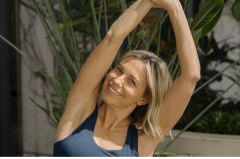There has been much fanfare in recent years about the vagus nerve (VN), with every podcaster, wellness influencer and yoga teacher preaching its capacity to moderate our wellbeing. But given most of us had probably never heard of the now-trending VN until recently, what exactly is the big deal with this big nerve, and how can we use our yoga practice to harness its power?
Parasympathetic nervous system
The etymology of the word “vagus” gives us some insight as to its function. “Vagus” comes from the old Latin “wandering”, and this is exactly what the VN does. The VN is a long and complex cranial nerve that meanders through so many parts of the body, it impacts many different aspects of our system. The VN makes up around three quarters of the parasympathetic branch of the autonomic nervous system and therefore plays a crucial role in regulating various bodily functions, including the heart rate, digestion and respiratory rate. Vagal tone indicates how well the vagal nerve is functioning, and a 2010 landmark study found that those with higher vagal tone had better overall heart health, lower levels of inflammation and a profound effect on aspects of wellbeing beyond our physical health.
Social and psychological wellbeing
In a study by social psychologists Barbara Fredrickson and Bethany Kok, genuine moments of social connectedness between people triggered the parasympathetic nervous system, toned the VN and created positive emotions. Participants also had stronger social bonds and exhibited better emotional regulation. In 2013, further research by Fredrickson and Kok found that practising loving-kindness meditation with yourself and others was the key to turbo-charging this upward spiral of vagal tone. There is an increasing understanding in the world of both psychology and physiology that working with the mind-body connection through body-based practices is the most effective way to address both physical and mental health issues.
Polyvagal theory
Polyvagal theory (PVT) offers a framework for understanding one way this mind-body connection plays out. PVT expounds how the autonomic nervous system, especially the VN, dictates our behaviour and overall health. We can either respond with calm and switch on the ventral vagal complex (VVC), which is associated with social engagement and feelings of safety. Or we may be mobilised, when the sympathetic nervous system (SNS) is triggered, stimulating the fi ght-or-fl ight response. Or immobilised via the dorsal vagal complex (DVC), which is related to our “shutdown” responses. These neural circuits are activated in response to what happens around us, our environmental cues and how safe we feel.
The gunas
Another framework we see embodying this mind- body connection, one of the yoga physiology models, is that of the gunas. Yoga philosophy says the gunas are fundamental qualities that constitute all of nature. Sattva represents clarity, harmony and balance. Rajas denotes activity, energy and movement. And tamas signifies inertia, darkness and stagnation. According to yoga, the interplay of the gunas influences an individual’s physical, mental and emotional states. The mental state will impact the physical and vice versa.
Polyvagal theory meets the gunas
The similarities between PVT and the gunas lie in these parallel structures. Sattva and the relaxed VVC are both associated with states of social connection and calm wellbeing. Rajas and the mobilised SNS both relate to activation and energy. Tamas and the immobilised DVC both correspond to withdrawal and conservation of energy. Understanding this connection between the gunas and PVT provides a comprehensive perspective on how yoga practices can influence our nervous system and therefore our overall wellbeing. PVT suggests self-regulation and social connection are key in promoting relaxation and reducing stress, and yoga is a tried-and-tested way to foster these qualities.
Yogic practices
Awareness of imbalances in the gunas and the associated neural circuits allows us to choose practices that restore balance. For example, calming, yin-based yogic practice may help bring you back into a sattvic state. Conversely, activating yang practices may help reawaken your system. Ultimately, all yogic practices are aimed at bringing you back to a sattvic state, where the VN is toned and the nervous system is purring like a kitten, rather than roaring like a hot V8 engine in overdrive.
Yogic tools for the VN
Asana (physical poses), Drishti, meditation and mindfulness cultivate awareness and clarity, reinforcing sattva and facilitating a harmonious autonomic state. Pranayama (breathwork) stimulates the VN, activating the calm VVC and supporting sattvic qualities. Research has found that controlled breathing patterns, characterised by slow, deep inhalations and extended exhalations, directly stimulate the VN. This stimulation enhances parasympathetic tone, promoting a state of relaxation and counteracting stress responses. Chanting activates the vocal chords, stimulating the VN at a vibrational level. Integrating these tools and practices supports emotional regulation, stress reduction and greater resilience.
The beauty of all this is that we can work with the VN in lots of different, practical ways as





